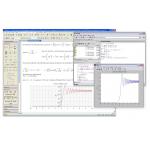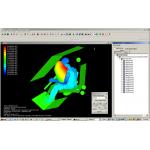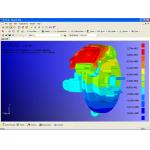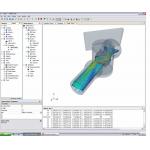Latest News
June 1, 2006
By DE Editors
On June 26, Maplesoft announced the Maple Toolbox for MATLAB (MTM). MTM provides seamless integration of the Maple 10 complex mathematics and technical document solution with the MATLAB technical computing environment from The MathWorks. MTM creates a bidirectional environment in which you can to define variables in one environment and use them in the other.
MTM has two components: Maple 10 and Maple-MATLAB Connector. The Connector is an add-on to Maple 10 that provides the two-way link between Maple and MATLAB. It is what enables users to develop, for example, a symbolic or a numeric math solution in Maple 10 and perform in-depth analysis of the results in MATLAB.
|
|
| The Maple Toolbox for MATLAB |
Maplesoft says that the Maple Toolbox for MATLAB features include an interactive technical document interface and a 2D equation editor for typeset-quality mathematical presentation. Among its additional capabilities are statistics, optimization, enhanced graphics, scientific constants, units, tolerances, more than 50 interactive assistants and tutors, and the ability to generate code in C, FORTAN, Visual Basic, Java, or MATLAB.
Maplesoft plans to make a public beta version of the Maple-MATLAB Connector available on its website. The final shipping version of the Maple-MATLAB Connector and the complete Maple Toolbox for MATLAB is planned in August.
Single-user licenses of the complete MTM, which includes both Maple 10 and the Maple-MATLAB Connector, will cost $2,195; volume, government, and academic discounts are available. Maple 10 users will be able to retrofit the Maple-MATLAB Connector separately, but pricing for that option was not available at press time. For complete details, go to Maplesoft by clicking here.
Collaboration Tool Designed for Engineers
VCollab suite for CAD, CAM, and CFD visual sharing end to end.
Visual Collaboration Technologies, Inc., says that its new VCollab 2006 software suite provides a common platform for viewing and manipulating 3D CAD, CAM, CAE, CFD, and FEA files authored in different engineering formats without requiring the native applications. VCollab 2006 delivers its visualizations of multidisciplinary product engineering data using a single lightweight viewing technology. VCollab files can be embedded into Microsoft Office applications or opened directly within Internet Explorer.
The VCollab 2006 suite contains three modules: VCollab Pro, VCollab Presenter, and VCollab CAE. The software provides both graphics tools and compression technology to reduce file size while preserving engineering content.
|
|
| VCollab 2006 |
VCollab Pro is said to be a scalable, high-performance visualization solution that converts large 3D CAD, CAM, and CAE data sets to a highly compressed format known as .vcb. A file saved in .vcb format, claims the company, loads up to 100 times faster than it does in its native authoring format. VCollab Pro also provides an array of tools for visualizing 3D digital models and simulations.
VCollab Presenter viewing software enables nontechnical users to view and manipulate 3D CAD, CAM, and CAE information. In Addition To Internet Explorer, you can also use Microsoft Word, Excel, and PowerPoint to access and manipulate .vcb files.
VMove CAE is a direct native reader of CAE output results. It converts native CAE results files into the highly compressed .vcb format based on user inputs. VMove CAE supports such CAE applications as ANSYS, ABAQUS, LS-DYNA, and MSC Nastran.
For complete details, or to sign up for an evaluation copy or get a demo, click here.
IMSL C# and JMSL Numerical Libraries Enhanced
Linear programming optimization, classification neural networks, and visualization tools key changes in V4.0 IMSL C# and JMSL.
Visual Numerics released the 4.0 versions of its IMSL C# and JMSL Numerical Libraries June 14. Both, says VNI, include a high-performance dense linear programming optimizer, classification neural network technology, and enhanced charting.
V4.0 of the libraries offers up to 100 tested classes that provide standard methodologies as well as mathematical and statistical algorithms for quantitative model development. Their high-performance dense linear programming optimizers, VNI claims, are the fastest and most robust optimizers in pure Java or C# of their kind.
A Classification Neural Net algorithm expands the forecasting functionality in the JMSL by categorizing data to identify groups that are more likely to perform certain behaviors. Also new is a VNI-supported—not freeware—Mersenne Twister algorithm for Monte Carlo simulations. JMSL also has been enhanced with new 3D chart plotting features, including surface and 3D scatter charts; 2D charting for IMSL C# is planned.
Both libraries are available now. A single seat of the IMSL C# Numerical Library 4.0 is $995. The JMSL Numerical Library for Java 4.0 costs $2,895 per development seat. For more details, click here.
No More Waiting for Corporate NASTRAN
NASTRAN L-Series offers affordable access to NASTRAN without waiting for corporate copy.
The MacNeal Group LLC say its new NASTRAN L-Series is a true NASTRAN system for the CAE users needing affordable, individual access to NASTRAN capabilities without the wait for the corporate NASTRAN resources to be freed up. Three flavors comprise the company’s NASTRAN L-Series product suite—Linear static; linear static and modal; and linear static, modal, and dynamic analyses—with each offered for a one-time charge.
NASTRAN L-Series, says the company, is not a NASTRAN emulator. Rather, it’s based on a “true” NASTRAN architecture with scalable matrix operations. Further, the L-Series can be used in conjunction with most of popular FE (finite element) pre and postprocessors.
|
|
| L-Series NASTRAN from The MacNeal Group. |
Each L-Series product has a full range of modeling tools, such as grids, elements, constraint elements, material properties, loads, and constraints. Additionally, all the L-Series products are said to provide the ability to use standard DMAP sequences, modify them, or develop your very own.
The L-Series leverages off the base unit NASTRAN-LS, which provides linear static analyses, including inertia relief. NASTRAN-LM adds normal modes analysis and eigenvalue buckling analyses. NASTRAN-LD has all of this plus complex eigenvalue analysis and frequency and transient response analyses using either the direct or modal formulations.
NASTRAN L-Series runs on Windows 2000/ XP. Pricing ranges from $995 to $2,995 and is available by clicking here.
New 3D Viz Solution Enters Analysis Market
Written for use with Win 2000 and XP, supports data from many sources.
Voxler is a new 3D data visualization software program by Golden Software (Golden, CO). Data is displayed in a variety of 3D images, including volume rendering, isosurfaces, contours, three dimensional slices, orthographic and oblique images, scatter plots, stream lines, and vector plots.
According to a press release, Voxler supports importing data from a number of sources, including ASCII data, Surfer GRD, DEM, HDR, IMG, and IV formats, and offers 18 export formats, including IV, TIF, BMP, and JPG.
Additional features include the ability to add axes to the image, add a bounding box to show the limits of the data, easily filter data to eliminate anomalies or duplicate points, perform calculations on the data, and rotate, slice, and dissect the image in real-time by simply dragging the mouse.
Voxler is written for use with Windows 2000 and XP. Price: $359. For more information, click here. To download a demo, click here.
CD-adapco Unveils STAR-CCM+ V2
Solution adds state-of-the-art meshing and advanced physics.
CD-adapco (London, England and Melville, NY), a provider of full-spectrum CFD solutions, has announced the second major release of STAR-CCM+. First released in 2004, this updated release of STAR-CCM+ adds state-of-the-art meshing technology and advanced physics to STAR-CCM+‘s capabilities.
|
|
| STAR-CCCM+ |
Following the “from the ground up” philosophy that was the inspiration behind its original development, the mesh generation technology of this release has been rewritten. According to a press release from CD-adapco, the resulting process, from surface import to postprocessing, is more robust, more powerful, and more automatic than before. The meshing capabilities include a surface wrapper for automatic repair, polyhedral meshing, and solver-optimized meshing.
STAR-CCM+ V2 has new physical models and features, including free-surface and volume of fluid (VOF) models, combustion and radiation models, boundary-layer transition capability, and external aerodynamics as well as under-hood simulations.
CD-adapco will be running a number of free webinars to showcase STAR-CCM+‘s meshing capabilities. Click here for details.
Subscribe to our FREE magazine, FREE email newsletters or both!
Latest News
About the Author
DE’s editors contribute news and new product announcements to Digital Engineering.
Press releases may be sent to them via [email protected].










